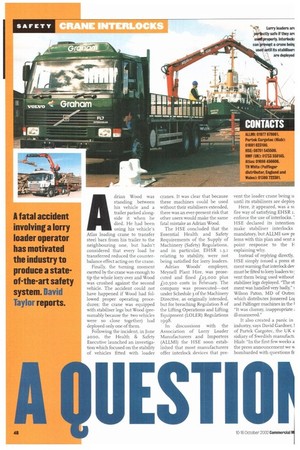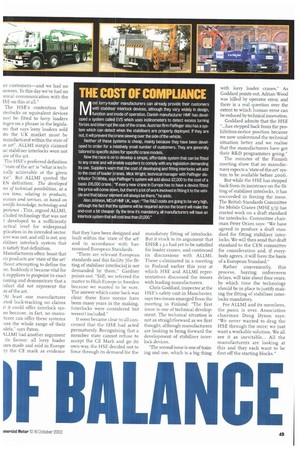!JEST
Page 48

Page 49

If you've noticed an error in this article please click here to report it so we can fix it.
ALANCE A fatal accident involving a lorry loader operator has motivated the industry to produce a stateof-the-art safety system. David Taylor reports. Adrian Wood was standing between his vehicle and a trailer parked alongside it when he died. He had been using his vehicle's Atlas loading crane to transfer steel bars from his trailer to the neighbouring one, but hadn't considered that every load he transferred reduced the counterbalance effect acting on the crane.
Finally, the turning moment exerted by the crane was enough to tip the whole lorry over and Wood was crushed against the second vehicle. The accident could not have happened if Wood had followed proper operating procedures; the crane was equipped with stabiliser legs but Wood (presumably because the two vehicles were so close together) had deployed only one of them.
Following the incident, in June 2000, the Health & Safety Executive launched an investigation which focused on the stability of vehicles fitted with loader
cranes. It was clear that because these machines could be used without their stabilisers extended, there was an ever-present risk that other users would make the same fatal mistake as Adrian Wood.
The HSE concluded that the Essential Health and Safety Requirements of the Supply of Machinery (Safety) Regulations, and in particular, EHSR 1.3.1 relating to stability, were not being satisfied for lorry loaders.
Adrian Woods' employer, Meynell Plant Hire, was prosecuted and fined p23,000 plus fio,5c)o costs in February. The company was prosecuted—not under Schedule 3 of the Machinery Directive, as originally intended, but for breaching Regulation 8 of the Lifting Operations and Lifting Equipment (LOLER) Regulations
1998.
In discussions with the Association of Lorry Loader Manufacturers and Importers (ALLMI) the VISE soon established that most manufacturers offer interlock devices that pre
vent the loader crane being u until its stabilisers are deploy
Here, it appeared, was a si fire way of satisfying EHSR i. enforce the use of interlocks. ". HSE declared its intention make stabiliser interlocks mandatory, but ALLMI saw px lems with this plan and sent a point response to the F. explaining why.
Instead of replying directly, HSE simply issued a press st ment warning that interlock dev must be fitted to lorry loaders to vent them being used without stabiliser legs deployed. The St ment was handled very badly,"1 Wilson Paton, MD of Outre'i which distributes Jonsered Loi and Palfinger machines in thei "It was clumsy inappropriate . ill-mannered."
It also created a panic in industry, says David Gardner, 1 of Partek Cargotec, the UK s sidiary of Swedish manufacti Hiab; "In the first few weeks a the press announcement we A bombarded with questions fr
ur customers—and we had no nswers. To this day we've had no )rmal communication with the NE on this at all."
The HSE's contention that iterlocks or equivalent devices lust be fitted to lorry loaders inges on a phrase in the legislaon that says lorry loaders sold Ito the UK market must be nanufactured within the state of ie art". ALLMI simply claimed lat stabiliser interlocks were not ate of the art.
The HSE's preferred definition 'state of the art' is "what is tech.cally achievable at the given ale". But ALLMI quoted the EN definition: The developed ate of technical possibilities, at a ven time, relating to products, ocesses and services, as based on ientific knowledge, technology and perience . This, argued ALLMI, cluded technology that was not t developed to a sufficiently actical level for widespread
■ plication in its intended sector, iere was not, and still is not, any ibiliser interlock system that 11 satisfy that definition.
Manufacturers often boast that eir products are 'state of the art' thout attempting to define the an. Suddenly it became vital for K. suppliers to pinpoint its exact eaning and demonstrate that a oduct did not represent the Lie of the art.
-At least one manufacturer irted back-tracking on claims it it could offer interlock sysns because, in fact, no manuturer can offer these systems -oss the whole range of their xiels," says Paton.
4LLM I had another argument its favour: all lorry loader Lnes made and sold in Europe -ry the CE mark as evidence
that they have been designed and built within the 'state of the art' and in accordance with harmonised European Standards.
"There are relevant European standards and this facility the fitting of stabiliser interlocks] is not demanded by them." Gardner points out. "Still, we referred the matter to Hiab Europe in Sweden because we wanted to be sure. The answer which came back was clear: these Euro norms have been many years in the making. Interlocks were considered but weren't included."
It soon became clear to all concerned that the HSE had acted prematurely. Recognising that a member state cannot refuse to accept the CE Mark and go its own way, the HSE decided not to force through its demand for the mandatory fitting of interlocks. But it stuck to its argument that EHSR 1.3.1 had yet to be satisfied for loader cranes, and continued its discussions with ALLMI. These culminated in a meeting in Finland earlier this year at which HSE and ALLMI representatives discussed the issues with leading manufacturers.
Chris Goddard, inspector at the HSE's safety unit in Manchester, says two issues emerged from the meeting in Finland: "The first issue is one of technical development. The technical situation is not as straightforward as we first thought, although manufacturers are looking to bring forward the development of stabiliser interlock devices.
"The second issue is one of training and use, which is a big thing
with lorry loader canes." As Goddard points out, Adrian Wood was killed by operator error, and there is a real question over the extent to which human error can be reduced by technical innovation.
Goddard admits that the HSE "...has stepped back from the prohibition-notice position because we now understand the technical situation better and we realise that the manufacturers have got their R&D programmes going."
The minutes of the Finnish meeting show that no manufacturer expects a 'state-of-the-art' system to be available before zoo6.
But while the HSE has stepped back from its insistence on the fitting of stabiliser interlocks, it has succeeded in forcing the issue. The British Standards Committee for Mobile Cranes (MHE 3/5) has started work on a draft standard for interlocks. Committee chairman Peter Oram says: "We have agreed to produce a draft standard for fitting stabiliser interlocks. We will then send that draft standard to the CEN committee for consideration and, if everybody agrees, it will form the basis of a European Standard."
Rather conveniently, this process, barring unforeseen delays, will take about four years, by which time the technology should be in place to justify making the fitting of stabiliser interlocks mandatory.
For ALLMI and its members, the panic is over. Association chairman Doug Dyson says: "We never wanted to drag the HSE through the mire; we just want a workable solution. We all see it as inevitable... All the manufacturers are looking at this and they each want to be first off the starting blocks."




































































































































































